|
Made With |
|
|
|
|
Dr. Hoffer's Travel Site This site was last updated 03/03/11 |
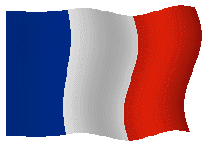

![]() FRAN2005 #30 N�MES to
GRENOBLE
FRAN2005 #30 N�MES to
GRENOBLE
![]()
Flag of Grenoble
Monday July 18, 2005
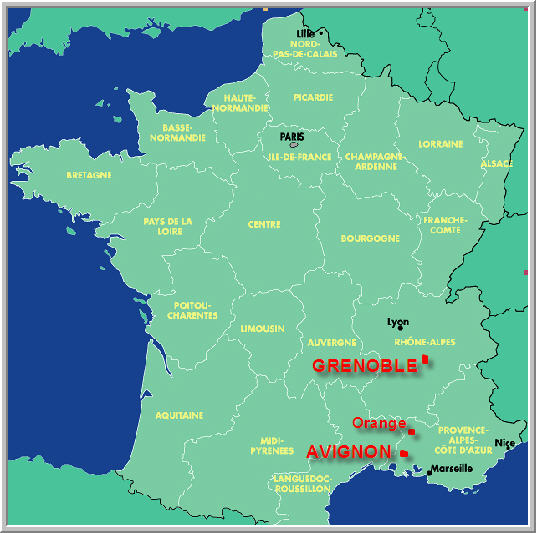 It was surprising because this
morning I woke up and got up at
9:15 and then headed out for my run at
10:00. I was really cooking. I had studied the city map and aimed my
run toward the Roman Temple and did it with rain gear and an umbrella.
It was surprising because this
morning I woke up and got up at
9:15 and then headed out for my run at
10:00. I was really cooking. I had studied the city map and aimed my
run toward the Roman Temple and did it with rain gear and an umbrella.
N�mes was originally called Nemauses after the god the people worshipped at a sanctuary alongside a spring. It became the capital of the Volcae Areconae tribe when the Romans conquered it and renamed it Colonia Nemausensis. These Romans were the veterans of Octavian (later to become Augustus) who had defeated Anthony and Cleopatra. In the 13th Century, it became the center of the Albigensian heresy (after the Bogomils and the Cathar heresy and HERE) until 1226 when it was squashed out by Louis VIII.
Albigensianism (of Albi, but primarily Toulouse) was not a Christian heresy but an extra-Christian religion descended from the Cathars. The dualism of the Albigenses was the basis of their moral teaching. It began with contact with Oriental thinkers and was introduced into France by an Italian woman.
They taught that man is a living contradiction. Hence, the liberation of the soul from its captivity in the body is the true end of our being. To attain this, suicide is commendable; it was customary for them do do this in the form of the endura (starvation). The extinction of bodily life is also a perfect aim. Since reproduction propagates the slavery of the soul to the body, perpetual chastity should be practiced. Matrimonial intercourse is unlawful; concubinage, being of a less permanent nature, is preferable to marriage. The members of the sect were divided into two classes: the "perfect" (perfecti) and the mere "believers" (credentes). The "perfect" were few in number and they submitted to the initiation-rite (consolamentum) which bound them to the observance of the above-described rigid moral law. Sounds like fun. The only bond that attached the "believers" to Albigensianism was the promise to receive the consolamentum before death. If the did and the illness did not kill them, starvation or poison was used to prevent subsequent moral transgressions. To learn more, click the link above.
St-Dominic (Dominic de Guzman) started the Dominican orders here during those troubled times. These wars of religion lasted for 300 years until Albigensianism was totally extinguished by the end of the 14th Century. The Jews were exiled in 1389 and in the 16th Century the city became Calvinist and was a hotbed of Huguenots for centuries.
I made it to the other end of the city and to a park with sculptures. The signs here keep an automatic count of how many spots are free (places libres) in each parking area.
As I was walking back, I came across this little circular park with a statue of Augustus Caesar.
I kept heading in the direction of the coliseum when I came across this monument cum park plaza. It didn't say what it was honoring so maybe it was just a decorative space. The stone (lower left) has a little face-fountain on the other side.
The fountain empties into this little canal ending in a male head fountain.
At the other end of the space is this 4-column pool fountain with bronze statues. There were wooden tables and umbrellas nearby for relaxing.
Continuing down the Blvd Daudet (remember him), I noted this beautiful
tree-lined
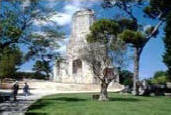 canal
called Qaui de Fontaine which leads west directly to the Jardin de la Fontaine,
the Temple de Diane, the Nymph�e and
the Tour Magne. The latter is the oldest Roman monument in Gaul and sits
on Mt. Cavalier (photo left). It is a 106 ft (32 m) high octagonal tower
that used to be part of the city wall. If I had known this I would have
walked to see them but since it was raining I might have passed it up anyway.
canal
called Qaui de Fontaine which leads west directly to the Jardin de la Fontaine,
the Temple de Diane, the Nymph�e and
the Tour Magne. The latter is the oldest Roman monument in Gaul and sits
on Mt. Cavalier (photo left). It is a 106 ft (32 m) high octagonal tower
that used to be part of the city wall. If I had known this I would have
walked to see them but since it was raining I might have passed it up anyway.
At 10:30 I finally arrived at the Roman Temple called Maison Carr�e ("square House" though it is not square) and I thought it was spectacular and very well preserved. I couldn't stop taking photos of it. Here it is from the front left and front right.
It was built in 19 BC by Agrippa in honor of his two sons, Caius Caesar and Lucius Caesar, grandson and adopted son of the Emperor Augustus (they died young). It was part of the forum, the business and administrative centre of the ancient city. Here it is from the right and back right.
Inspired by the temples of Apollo and Mars Ultor in Rome, the Maison Carr�e is a
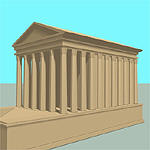 pseudoperipteros
temple and has extremely harmonious proportions. Napoleon copied it
when building Madeleine. It is the only temple of the antique world that
has survived whole and is 85 ft (26 m) long, 50 ft (15 m) wide and 56 ft (17 m)
high. [Click left photo for more info] It escaped the plan of
Colbert to dismantle it and move it to Versailles. The ceiling of the
pronaos dates from the beginning of the 19th Century and the present
door was fitted in 1824. Here it is from the left side and back right.
pseudoperipteros
temple and has extremely harmonious proportions. Napoleon copied it
when building Madeleine. It is the only temple of the antique world that
has survived whole and is 85 ft (26 m) long, 50 ft (15 m) wide and 56 ft (17 m)
high. [Click left photo for more info] It escaped the plan of
Colbert to dismantle it and move it to Versailles. The ceiling of the
pronaos dates from the beginning of the 19th Century and the present
door was fitted in 1824. Here it is from the left side and back right.
The Maison Carr�e is exceptionally well-conserved because it has been used without interruption since the 11th Century, serving in turn as a fortress for the Visigoths, a chamber of the consuls, stables, apartments and a church. It was the headquarters of the first prefecture of the Gard department after the French Revolution and later turned into the departmental archives and then it inaugurated the creation of museums in N�mes in 1823. It really is a beautiful structure. There was a row of columns to the right of the temple but they have been lost. The remnant stubs are on the right.
Here you can see the fine detail of the Corinthian columns.
I could see that you could go inside so I climbed the stairs and went in the front door. The portico was beautiful and the preservation of the ceiling detail was superb.
The ceiling inside was even nicer. It is now the Museum of Antiquity and they have many Roman statues inside that had been excavated from near the temple. You can see the statue of Venus.
There were also several excellent examples of Roman tile work and mosaics.
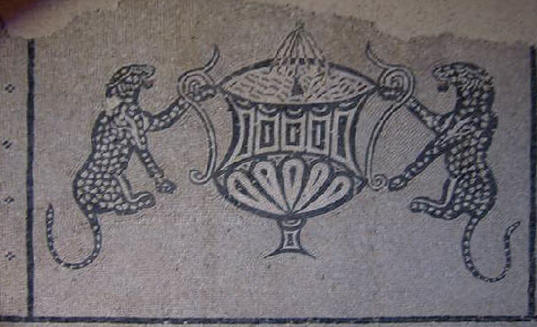
Right across the street from the Temple at Via Domitia is the Carre d'Art Museum, a controversial 5-floor glass structure built in 1993 by Sir Norman Foster, a British architect.
I looked down some of the side streets which were very clean and had a lot of shops. You can see where the French influence created the iron railings they have in the French Quarter in New Orleans. I then went back down the main tree-lined boulevard called Victor Hugo (below right).
I came upon the Eglise St-Paul which was very large but it was closed. The tympanum above the main door was exquisite (below right).
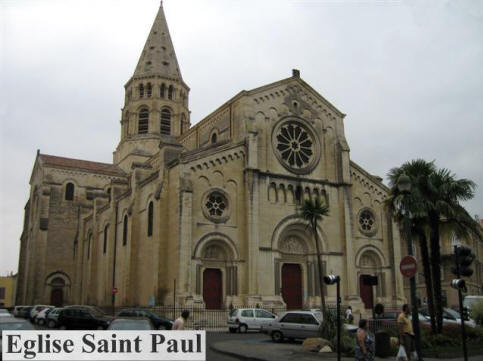
At 11:00 I finally arrived at the Coliseum and I walked around the outside. I'm not sure whether it was open, but I couldn't find any easy access to the interior. Since I saw the one in Arles, I gave up.
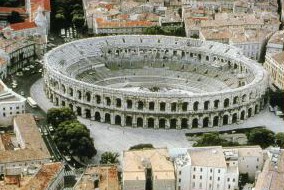 Built
at the end of the first century AD, the amphitheatre of the city of
N�mes
was among the biggest in Roman Gaul. There are 70 remaining Roman
coliseums in the world and this one is rated as either the 12th or the 20th
largest. It measures about 436 ft (133 m) in length and 331 ft (101 m)
wide. The facade, 69 ft (21 m) high, consists of two levels of 60 arches
each. Inside, more than 20,000 spectators could attend the fights of the
gladiators. A complicated system of corridors and stairs allowed each of
the spectators to quickly reach their seat or to leave the building at the end
of the performance. Today, the amphitheatre of N�mes is one of the most
well preserved of the Roman world.
Built
at the end of the first century AD, the amphitheatre of the city of
N�mes
was among the biggest in Roman Gaul. There are 70 remaining Roman
coliseums in the world and this one is rated as either the 12th or the 20th
largest. It measures about 436 ft (133 m) in length and 331 ft (101 m)
wide. The facade, 69 ft (21 m) high, consists of two levels of 60 arches
each. Inside, more than 20,000 spectators could attend the fights of the
gladiators. A complicated system of corridors and stairs allowed each of
the spectators to quickly reach their seat or to leave the building at the end
of the performance. Today, the amphitheatre of N�mes is one of the most
well preserved of the Roman world.
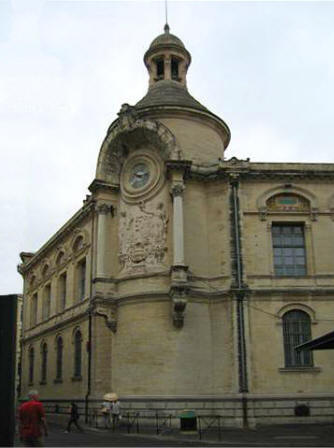
After going around the back side, I circled around to see this pretty building (upper right) and then at 11:30 I desperately needed a cappuccino and stopped at this lovely little outdoor place near the coliseum called Le Petit Caf� Bourse (green awning) right next to the Grand Caf� La Bourse (red awning). It was very tricky getting a seat so that the rain didn't drip down on you. This was not a cappuccino; it came with whipped cream and chocolate all over it and it was just terrible. I could barely drink it.
This is the view I had of the coliseum from the caf�.
[Looking at the pictures now, I can see the umbrellas at the top, meaning people were getting inside and I never found the entrance in the rain - Oh well.]
Somehow I missed seeing the Cath�drale Notre Dame et St-Castor consecrated in 1096 but flattened by the Huguenots in 1597 and again in 1622. We also missed the Mus�e Arch�ologique, Mus�e de Vieux N�mes and the Mus�e Beaux Arts. I wended my way back to the room and came by this bronze statue of a bullfighter on the other side of the coliseum.
When I got near the hotel I had to walk across this large circular park (that we circled several times on our arrival) called Esplanade Charles De Gaulle and I came across this elaborate memorial to French soldiers. After I entered the gate, there was this large statue fountain and then.....
.....I came across this large circular hole with this memorial. You can see the list of names on the circular surrounding wall. Across the park, the hotel is right next door to a beautiful cathedral called St-Perp�tue, that was always closed.
At 12:00 I arrived back at the room and changed. At 1:30 we checked out of the hotel and I had the guy at the desk book us a room in Grenoble at an Ibis Hotel (the cheapest in the chain.) We would finely be heading out of Provence and no free champagne tonight.
At 1:45 I was shopping in a Monoprix and found a nice blue shirt for �7. At 2:15 we drove to the Castellum which was an old fortress but now houses the University de Vauban (remember Vauban was the great military advisor to Richelieu). One of the few universities with a moat around it. I walked up inside and believe it or not, there were students running around to their classes. Nothing to see so I left.

At 2:30 Marcia drove out of N�mes and we headed to the famous site of Pont du Gard, the largest and most preserved aqueduct bridge there is. You can see on the map (below left), it is half way between N�mes and Avignon.
We got there at 3:00 and had to pay �5 apiece to get in and then take this long walk to get to the visitor center (below right).
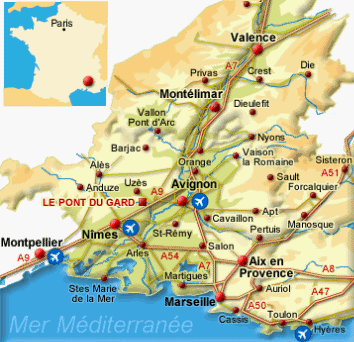
 After that there was even a longer walk (map below right) to get to the site
where the aqueduct crosses the Gardon River which empties into the Rh�ne.
In 19 BC, Augustus had Agrippa build this aqueduct (brown line in map below
left) to carry water from a special spring they found in Uz�s (called Fontaine
d'Eure) to N�mes after their spring could not supply enough water.
[Left: Pont du Gard at night]
After that there was even a longer walk (map below right) to get to the site
where the aqueduct crosses the Gardon River which empties into the Rh�ne.
In 19 BC, Augustus had Agrippa build this aqueduct (brown line in map below
left) to carry water from a special spring they found in Uz�s (called Fontaine
d'Eure) to N�mes after their spring could not supply enough water.
[Left: Pont du Gard at night]
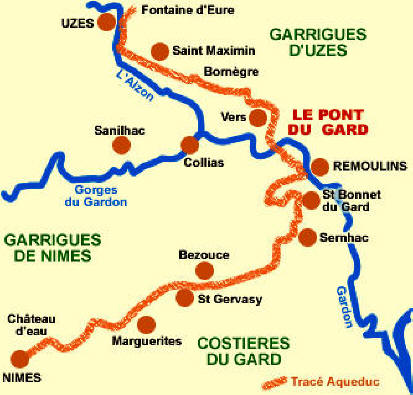
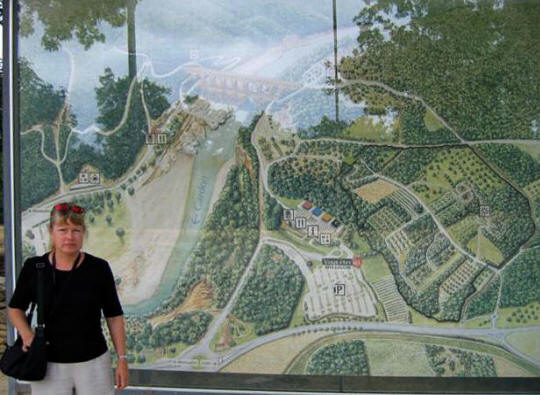
The Pont du Gard is just spectacular and we were able to walk across the lower portion of it. Below left is a model of it and then three stock photos.

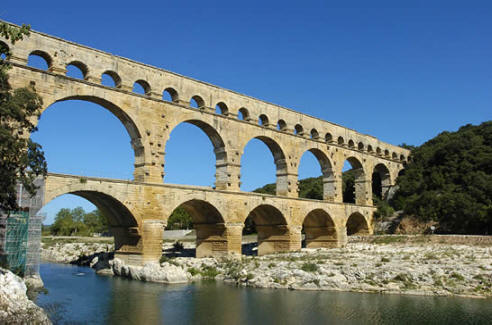
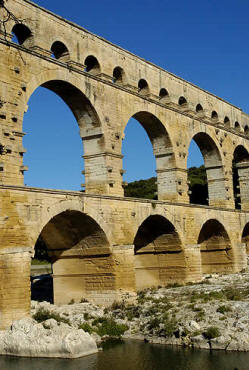
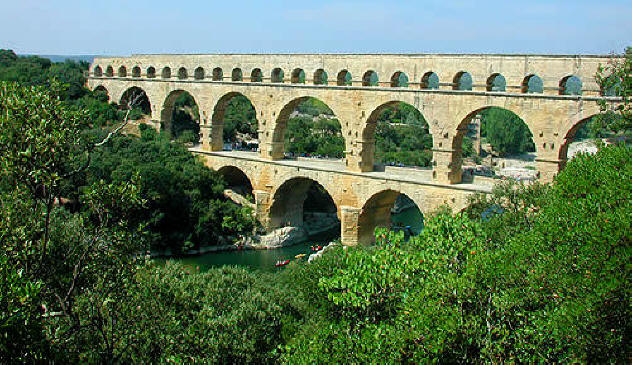
The rest are shots we took. Here is the view as you get closer and closer to it.
When you come up on the view of the whole Pont, you are just in awe that this thing was built with 6 ton stones using no cement or mortar over 2,000 years ago.
.jpg)
Your perception of it changes as you get closer to it. There are 2 million people who visit here each year. The novelty of this bridge is that it is made up of three levels of receding arches placed one above the other and therefore completely independent of one another. The total height of the bridge from water level is 131 ft (40 m). The bottom series of 6 arches is 466 ft (142 m) long, the middle with 11 arches is 794 ft (242 m) long and the top has 35 arches and is 902 ft (275 m).
Once you get on the bridge itself and start walking across it, you are taken by the sheer immensity of it. Note the holes the Romans put in it for future scaffolding.
2.jpg)
This is the view of the Gardon River to the south; left and right views. You can see the bathers are having a good time in the river in the distance.
And this is the Gardon River to the north. I was fascinated by this scrubby little olive tree all by itself next to the bridge.
Here are stock photos of the actual water canal at the very top which we were not allowed to get up to.
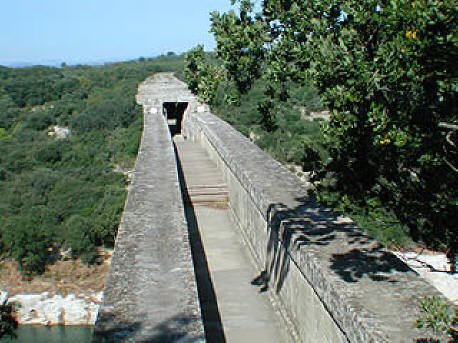
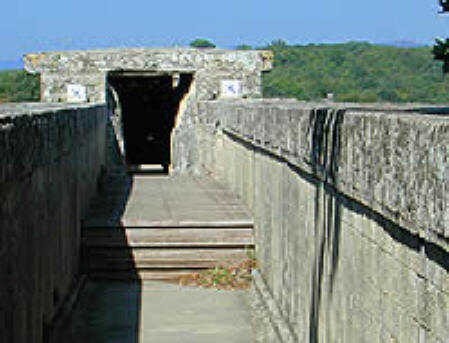
We went back to the visitor's center and of course there are a lot of shops so we bought some postcards, water, a pin and a book. I saw this set of boules for the French game called P�tanque which is similar to the Italian's bocce ball. Click the link to learn the rules. I almost bought it but Marcia talked me out of it due to its weight.
At 4:00 Marcia drove the 23 miles north to the ancient city of Orange and we passed through Remoulins on the way. At 4:30 we had to get gas and this tank full cost us �68 ($5.54/gal).
Orange was the ancient Celtic city of Arausio (after the local Celtic water god) and in 105 BC the Cimbri and Teutoni killed 100,000 Roman soldiers when Rome first attempted to take it. Well, they ultimately got it. Roman Orange was founded in 35 BC by veterans of the Second Gallica Roman legion as Arausio, or Colonia Julia Firma Secundanorum Arausio in full, "the Julian colony of Arausio established by the soldiers of the second legion."
In the 13th Century, most of the Roman structures were damaged badly
by the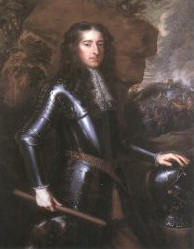 barbarian Alamani and Visigoths. In more modern times, the Prince of
Orange was the ruler of Holland but Louis XIV finally took Orange after his war
against Holland by the
Treaty of Utrecht in 1713. The United Provinces survived to become
The Netherlands, which
is still ruled by the House of Orange-Nassau.
William, Prince of
Orange, ruled England as William III of England. William endowed the
College of William and Mary in Williamsburg, Virginia in 1693. The modern
day Orange Order is named after him, and makes a point of celebrating his
victory at the Boyne when he ousted Catholic James II as King of England. Orange
marches in Ireland and Scotland on the 12th of July (the anniversary of the Battle
of the Boyne) often carry a picture of him with them. Hence "orange" is
often thought of as
barbarian Alamani and Visigoths. In more modern times, the Prince of
Orange was the ruler of Holland but Louis XIV finally took Orange after his war
against Holland by the
Treaty of Utrecht in 1713. The United Provinces survived to become
The Netherlands, which
is still ruled by the House of Orange-Nassau.
William, Prince of
Orange, ruled England as William III of England. William endowed the
College of William and Mary in Williamsburg, Virginia in 1693. The modern
day Orange Order is named after him, and makes a point of celebrating his
victory at the Boyne when he ousted Catholic James II as King of England. Orange
marches in Ireland and Scotland on the 12th of July (the anniversary of the Battle
of the Boyne) often carry a picture of him with them. Hence "orange" is
often thought of as
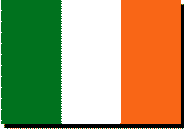 a
"Protestant" color in Ireland. The flag of the Republic of Ireland
includes the color orange, as well as white and green, and signifies the
aspiration to peace between Protestants and Roman Catholics in Ireland.
a
"Protestant" color in Ireland. The flag of the Republic of Ireland
includes the color orange, as well as white and green, and signifies the
aspiration to peace between Protestants and Roman Catholics in Ireland.
Orange gave its name to other Dutch-influenced parts of the world, such as the
Orange Free State in South Africa. Today the city of Orange has a population of
28,000 people, with a primarily agricultural economy. We arrived in Orange
at
4:40 and came across this huge sculpture of a woman taking off a mask.
We drove further and found their famous Roman Theatre. The photo (above right) shows the outside of the "frons scenae" of the theater which is the only one this complete left in the entire world. It was built by Emperor Augustus and is 338 ft (103 m) long and 118 ft (36 m) high. We parked up the hill and walked the whole front to find the entry. I almost balked at the entrance fee of �15 ($37 for the two of us) but the lady there coddled and chided me and told me the fee also included the museum across the street, so we went ahead. Marcia and I separated and I went inside to see this spectacular theater called Le Temple of Orange (stock aerial view below right).
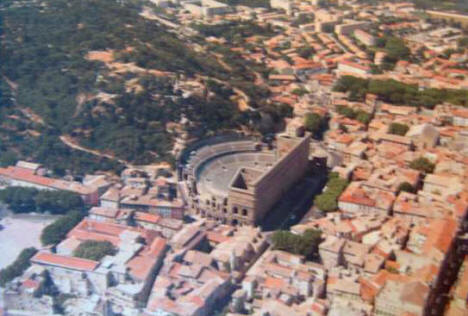
It was really exhausting but I made it all the way to the top and took this shot from the upper right side.
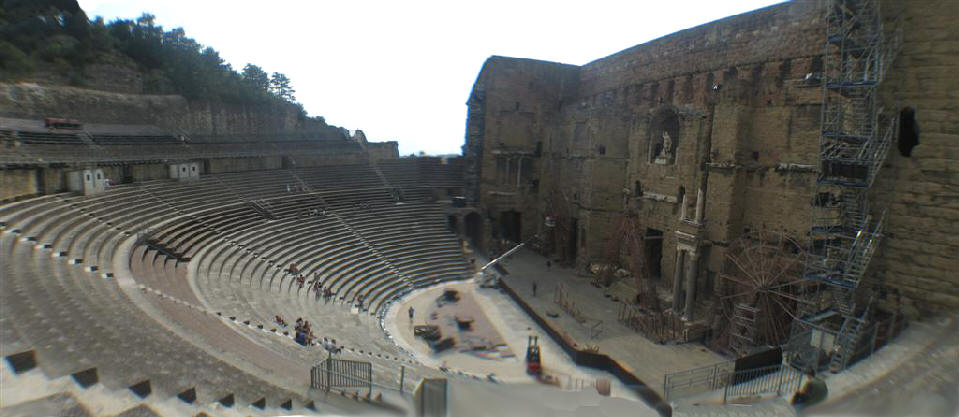
The theater originally had three levels and could hold 11,000 spectators while today it holds 7,000. Then I walked all the way to the upper left side and took this shot.
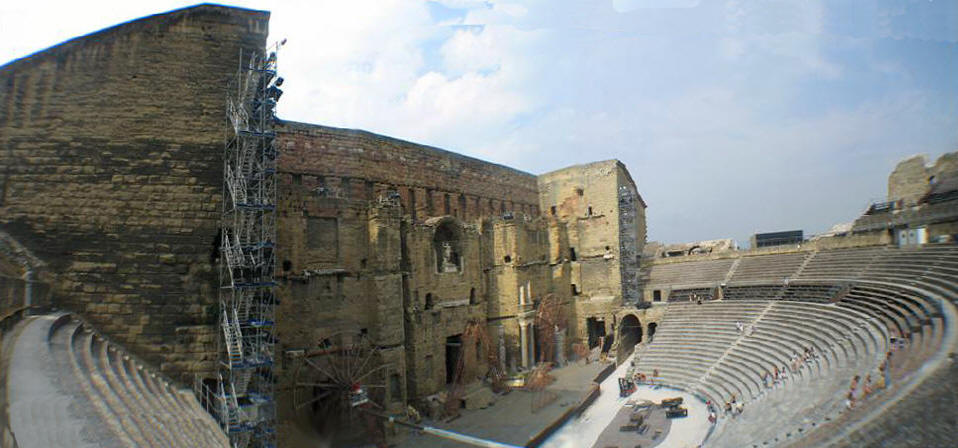
In 1950, this enormous statue of Augustus Caesar was put back together and placed back in this niche in the frons scenae.
At 11.7 ft (3.55 m) tall, it is one of the largest statues sculpted in the Imperial period.
The above are views through the various tunnels and walkways. While we were separated, Marcia got a little upset with me when she couldn't find me. My phone wasn't working right and she got worried. When we finally met back up at the visitor center we then went outside and across the street to the Museum.
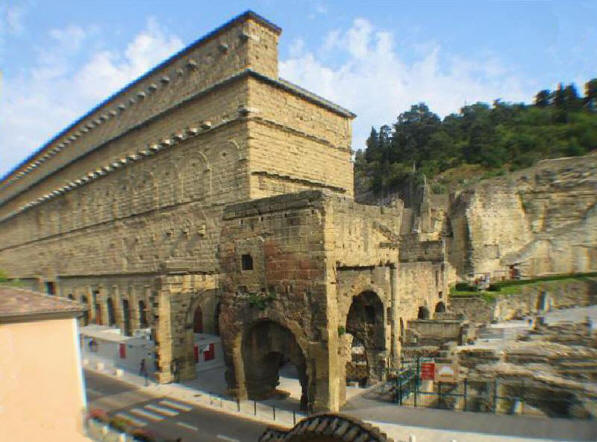
Right next door to the theater they have excavated the remains of the Gymnasium that measured 438 by 88 yds (400 by 80 m). The excavation is still in progress.
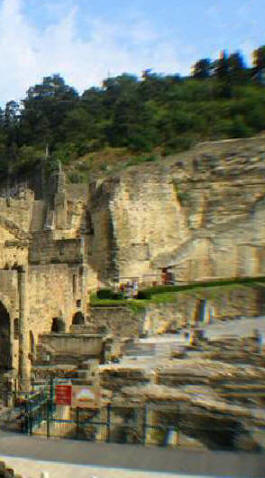
We crossed the street and went into their museum. They had a number of Roman artifacts including reliefs and tiles. Photography of any kind was absolutely forbidden, so I hope you enjoy the ones I got.
The displays went from Roman to more modern times.
.jpg)
They had many works by this French painter named Albert De Belleroche, who I had never heard of. They noted he was friends with John Singer Sargent (who painted the portrait of him, above right), Oscar Wilde, Renoir, and Toulouse Lautrec, which is quite a group. From the examples of his art that were displayed it seems that women were his favorite subject.
.jpg)
.jpg)
.jpg)
We headed out at 6:00 but did stop to photograph the beautiful Roman Arch d'Triomphe on the road out of town called Via Agrippa (from Arles to Lyon). It is really a commemorative arch celebrating Julius Caesar's victory in 49 BC. It was rededicated to Tiberius in 25 AD. It is 62 ft (19 m) long, 59 ft (18 m) high and 26 ft (8 m) wide. Here it is from the front and the left side.
And here it is from the back and the right side.
The sculpted pieces on this arch were to demonstrate and celebrate military victories.
Above and below are the main friezes on either side depicting war battles.
At 6:15 Marcia drove the 110 miles north to Grenoble, thus leaving Provence and entering the next French region called Rh�ne-Alpes at 6:30.
By 7:00 it became dark and very heavy raining and lightning started. All of a sudden I could see through all this storm, these very high mountains. I guess we really were entering the area of the Alps.
We pulled into the downtown of
Grenoble at
8:10 and checked into the Ibis Hotel Center, Place Felix Poulat, Room #319 [5 rue
Miribel, ![]() +33-(0)4-76-47-4849].
We had a hard time in the rain finding this hotel which was located in a
pedestrian center so we parked on rue de Belgrade and I walked down this little
pedestrian street (rue Miribel) (again). Marcia waited in the car while I umbrelled it
until I found it (lower right, [photos next day.])
+33-(0)4-76-47-4849].
We had a hard time in the rain finding this hotel which was located in a
pedestrian center so we parked on rue de Belgrade and I walked down this little
pedestrian street (rue Miribel) (again). Marcia waited in the car while I umbrelled it
until I found it (lower right, [photos next day.])
The entrance was nothing more than an elevator up to the reception floor. Then. after checking in, the gal told me where and how to park the car in their locked garage. Once we knew how to do it, it was just fine. We noted we had a McDonald's right below.
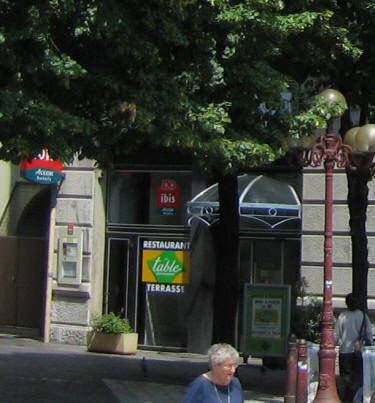
After drying off and unpacking, we decided to pass on the Ibis dining room and at 9:35, we headed out in the rain from place F�lix Poulat through the shopping street, rue de la Poste and place de l'�toile to rue de Strasbourg.
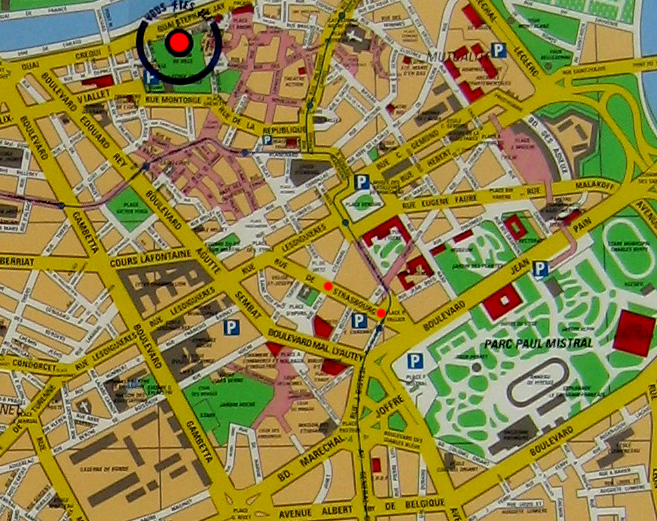
We were looking for a recommended restaurant called Le Berlioz [4 rue de Strasbourg,
![]() +33-(0)4-76-56-2239].
It was very dark and several blocks away in a strange city, but we found it.
+33-(0)4-76-56-2239].
It was very dark and several blocks away in a strange city, but we found it.
We weren't sure it was open this late on such a rainy Monday night but it wasn't locked so we went in. Finally a host showed up and took us across the completely empty room to our table. So we were set for a very private dining experience in what looked like a very classy restaurant. The host (dressed in formal attire) became the waiter and he handed us this handwritten menu in flowery script that was just about impossible to read even if it was in English.
Marcia started out with a glass of champagne and we ordered a bottle of our favorite Badoit and a bottle of Vouvray Domaine des Aubuisi�res (Cuv�e de Silex). He then brought us each a plate of a special cheese on bread which was very good.
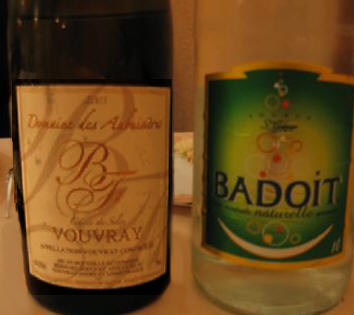
Since I had loved it in Arles, I ordered the Raviole de Royan a'la cr�me de basilic (�20). This time it was all mushed together like a glob and I did not care for it. I asked him to take it back. In place of it he brought me a foies gras sous la peau (on pears) which of course was very good.
I have been wanting to have some chicken, so I ordered Volaille de Bresse (chicken breast from city of Bresse) croquante morrilles (mushroom croquette) et (and) foie gras peis gourmandi (peas) et copeause d'asperges (chopped asparagus) au buerre demi-sel (semi-salted butter) (�23). Marcia had this little item and I can't remember what it is but she didn't care for it and she got it exchanged for.....
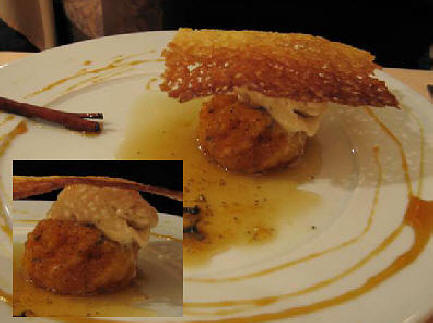
......a salad of langostine, asparagus and sugar lettuce with pastry and then had a seafood entree.
Marcia then chose her favorite dessert of chevre cheese with berry sauce.
The whole thing cost �147 ($181) and all in all, an unusual experience. We finished up and at 11:50 we walked back again in the rain to our hotel. I had a beer in the lobby and burned the photos onto a DVD and then went to bed at 1:20 AM.
Kenneth J. Hoffer, MD
Grenoble, France
Sent 2-5-06
If you enjoyed these travels or wish to add comments on the places we visited
Please Leave Me a Message by clicking the spinning @ sign.

